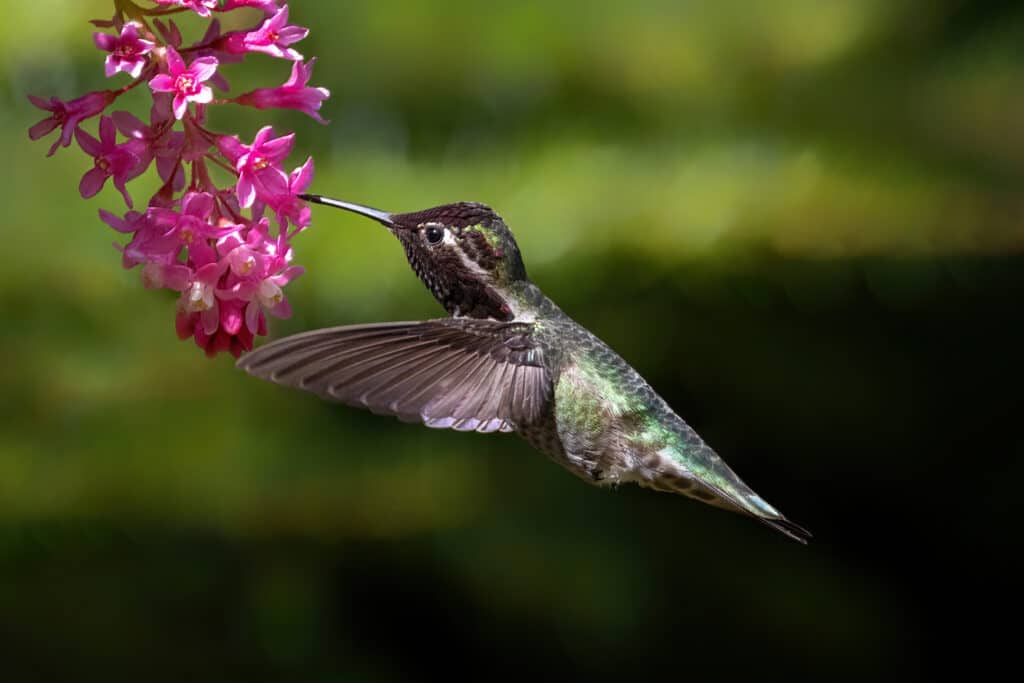Ever watch a hummingbird in action and wonder about the incredible speed and agility of these tiny, colorful marvels? Their fascinating aerobatics and rapid wingbeats can leave any bird lover in awe. But just how fast do these miniature aviators fly? Settle in as we embark on a journey to understand the amazing world of hummingbirds’ flight dynamics. It’s time to get our curiosity in gear and delve into the wonders of these speedy, little feathered acrobats!

With their brilliant white bellies, regal tails, and bright blue heads, white-necked jacobin hummingbirds (
Florisuga mellivora) are difficult to overlook.
©Martin Pelanek/Shutterstock.com
How Fast Can Hummingbirds Fly?
Hummingbirds can zip through the air at impressive speeds up to 30-60 mph. This makes them faster than many land animals, and even some birds, despite their miniature size. Their average speed during regular flight lies between 25 to 30 mph, and they maintain this pace while darting from flower to flower. In special circumstances, like when trying to impress a mate, their speed can double to the staggering 60 mph mark. Hummingbirds can achieve these astounding speeds due to their lightweight bodies and uniquely structured wings, which not only support swift flight but also enable them to hover.
How Fast Can Hummingbirds Flap Their Wings?
Hummingbirds boast an unmatched mastery of aerial acrobatics. Their wing structure, unlike any other bird species, allows them to fly forwards, backward, and even upside down. They can change direction on a dime, showcasing nimble maneuvers that would make the most skilled pilots green with envy. This agile dexterity, combined with their breakneck speeds, makes them unmatched nectar collectors in the avian kingdom. Their rapid wing flaps, clocking between 50 to 200 beats per second depending on which specific species it is, and their ability to hover like helicopters as they sip nectar from flowers, further cement their status as one of nature’s most exceptional fliers.
How Far Can a Hummingbird Fly in One Day?
Hummingbirds are renowned for their stamina in flight. These pint-sized dynamos have been known to fly incredible distances in a single day. Some species, such as the ruby-throated hummingbird, undertake a non-stop, 500-mile journey across the Gulf of Mexico during migration! This is a feat that they manage to accomplish in a mere 18 to 22 hours, which roughly translates to an average speed of about 27 mph. Truly, these hummingbirds rival the endurance of any long-distance runner, all while achieving these feats while maintaining a wingspan of just around 4 inches.
How Do Hummingbirds Sustain Their Energy for High-Speed Flight?
Given their small size, it’s astonishing how hummingbirds maintain their high energy levels during rapid flight. You might ask yourself how they do it.
The secret behind their unwavering energy in high-speed flight resides in the hummingbird’s metabolism. Imagine running a marathon, then ten more, and maybe even another, all in a single day. That’s essentially the energy output of these winged wonders. Hummingbirds possess an incredibly high metabolic rate, with their heart beating as rapidly as 1,260 beats per minute, and a breathing rate of approximately 250 breaths per minute even at rest. This is nearly 100 times that of an elephant!
To support such an astounding metabolic rate, hummingbirds must consume an almost continuous supply of nectar — a sugary plant secretion rich in calories. The nectar fuels their flight muscles with glucose, providing immediate energy. The excess is stored as fat for long-distance travel. Some hummingbirds consume up to three times their body weight in nectar each day. Such a prodigious diet, relative to their size, means that these birds spend the better part of daylight hours foraging, pausing only for quick rests in between.

In order to sustain their astonishing metabolic rate, hummingbirds must consume a nearly continuous supply of nectar.
©iStock.com/Devonyu
How Does Their Unique Wing Structure Enhance Flight Efficiency?
A pivotal player in the high-speed aerial escapades of hummingbirds is their distinctive wing structure. Unlike their avian counterparts, hummingbirds boast a ball-and-socket joint at the shoulder, allowing their wings a sweeping 180-degree arc of movement. This unprecedented range of motion injects a flair of flexibility into their flight, granting them mastery of maneuvers most birds can only dream of.
Further compounding this advantage is the hummingbird’s ingenious ability to harness energy from both the upstroke and downstroke of each wing flap, courtesy of their signature figure-eight motion. This dual lift system is a game changer in terms of energy efficiency. While most birds expend energy mainly on the downstroke, hummingbirds exploit each oscillation of their wings to generate lift, thereby optimizing their energy usage. This mechanical marvel of nature amplifies their flight efficiency, fueling their breathtaking displays of speed and endurance in the sky.
The photo featured at the top of this post is © Devonyu /Shutterstock.com
Thank you for reading! Have some feedback for us? Contact the AZ Animals editorial team.






